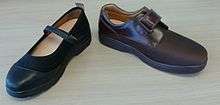Diabetic shoe

Diabetic shoes, sometimes referred to as extra depth, therapeutic shoes or Sugar Shoes, are specially designed shoes, or shoe inserts, intended to reduce the risk of skin breakdown in diabetics with co-existing foot disease.
People with diabetic neuropathy in their feet may have a false sense of security as to how much at risk their feet actually are.[1] An ulcer under the foot can develop in a couple of hours. The primary goal of therapeutic footwear is to prevent complications, which can include strain, ulcers, calluses, or even amputations for patients with diabetes and poor circulation.[2] Neuropathy can also change the shape of a person's feet, which limits the range of shoes that can be worn comfortably.[3] In addition to meeting strict guidelines, diabetic shoes must be prescribed by a physician and fit by a qualified individual, such as an orthotist, podiatrist or pedorthist. The shoes must also be equipped with a removable orthotic. Foot orthotics are devices such as shoe inserts, arch supports, or shoe fillers such as lifts, wedges and heels. The diabetic shoes and custom-molded inserts work together as a preventive system to help diabetics avoid foot injuries and improve mobility.
In the United States, diabetic shoes can be covered by Medicare.[4]
References
- ↑ Foot Complications, from the American Diabetes Association; first published no later than November 4, 2009 (as per archive.org); retrieved November 1, 2013.
- ↑ Diabetic Foot Care at ePodiatry; published 2003; retrieved September 6 2011.
- ↑ DeMello, Margo (September 10, 2009). Feet and Footwear: A Cultural Encyclopedia. Macmillan. pp. 92–94. ISBN 9780313357145.
- ↑ Therapeutic Shoes or Inserts, from medicare.gov. Accessed Nov. 1, 2013.